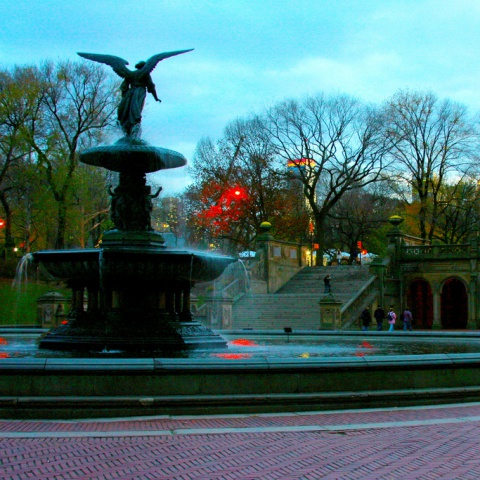Future City Lab: Central Park Then and Now
Changes to a Community Landscape
Interdisciplinary

Time Estimate: 2 sessions, 55 minutes each
Connection to Port City, 1609-1898: Confronting Density, 1810-1865
Connection to Future City Lab: Living with Nature: How can New York City enhance its natural environment and cope with climate change?
Objectives:
Students will:
- be able to compare and contrast Central Park’s past and current landscape using given images
- be able to identify factors that cause changes to community landscapes such as Central Park
Materials:
- Presentation (Sessions 1 & 2)
- Photos of Central Park’s Sheep Meadow (Set 1 and Set 2) (Session 1)
- See-Think-Wonder Think Sheet (Session 1)
- Post-it notes – two different colors (Session 1)
- Venn Diagram Think Sheet (Session 2)
Standards:
- CCSS.ELA-LITERACY.SL.2.1: Participate in collaborative conversations with diverse partners about grade 2 topics and texts with peers and adults in a small and large groups.
- CCSS.ELA-LITERACY.SL.2.2: Recount or describe key ideas or details from a text read aloud or information presented orally or through other media.
- CCSS.ELA-LITERACY.W.2.8: Recall information from experiences or gather information from provided sources to answer a question.
Guiding Questions:
- How does our land change over time?
- Why does our land change over time?
- What factors change our land over time?
- Hook/Building Background (10 minutes)
- Model – Introduce See, Think, Wonder Routine (10 minutes)
- Collaborative Partner Work (25 minutes)
- Share (10 minutes)
Procedures: Session 1
Show students Central Park on a current map of New York City.
Display photos of Central Park’s Sheep Meadow from Set 1 (See materials). Ask students to look at the pictures displayed. Explain that both pictures are showing the same place in New York City’s Central Park. Present guiding questions: How does our land change over time? Have students turn and talk about the guiding question using the photos of Central Park’s Sheep Meadow as reference.
Explain to students that they will use the See, Think, Wonder routine to help them better understand how Central Park has changed over time.
Look at the photo of Central Park from the past. Model the routine by stating what you see in the photograph (e.g. I see a lot of trees and grass.) Record what you see on a Post-it note. Place Post-it note on the three-column chart (see chart from See, Think, Wonder Think Sheet). Then model what the photo makes you think (e.g. This photo makes me think that it was a long time ago because there are not many buildings). Record your thinking on the same color Post-it note and place it on the three-column chart. Finally, state what you are still wondering or a question you might have (e.g. I wonder why there are sheep on the grass?).
Repeat the same process with Central Park from the present. Use a different color Post-it when recording.
Divide students into partnerships. Each pair will receive two photos of Central Park (Set 1 or Set 2), the See, Think, Wonder Think Sheet, and two different color Post-it notes. Students will work together to complete the see, think, wonder routine with the two photos.
As students work together, they should collaboratively discuss the questions before recording their thinking:
1.) What do you see?
2.) What does it make you think?
3.) What does it make you wonder?
Select students who had Set 1 and Set 2 of photos to share. Ask students to state one thing they see, think, and wonder. Encourage students to try to state a new idea if someone already shared their idea.
- Review (5 minutes)
- Model (5 minutes)
- Writing (15 minutes)
- Share/Present (5 minutes)
- Discussion (15 minutes)
- Exit Ticket (10 minutes)
Procedures: Session 2
Review the photos of Central Park from the past and present shown in Session 1. Briefly discuss what students saw in photos and what it made them think and wonder.
Using the See, Think, Wonder Think Sheet, students will complete the Venn diagram to compare and contrast Central Park in the past and present.
Explain that when you compare and contrast, you are figuring out how something is the same and different.
Working in partnerships, students will complete the Venn diagram by finding ways Central Park in the past and present are the same and how they are different.
Ask students to come together. Have them share the similarities and differences that they found. Record these on a larger class Venn diagram.
Tell students that Central Park is land that changed over time. Have students to turn and talk about: Why does our land change over time?
Then ask students: What factors change our land over time? Identify some factors that cause changes to land (e.g. population increases, more infrastructure such as buildings)
Ask students to select one of the factors that was discussed in Step 5. Have students write about which factor they think caused Central Park to change over time.
Additional Resources
Teacher Background: Article about See, Wonder, Think protocol explaining purpose and application
Fieldtrips: This content is inspired by the Port City, 1609-1898 and Future City Lab galleries in the Museum’s flagship exhibition, New York at Its Core. If possible, consider bringing your students on a fieldtrip! Visit http://mcny.org/education/field-trips to find out more.
Acknowledgements
This series of lesson plans for New York at Its Core was developed in conjunction with a focus group of New York City public school teachers: Joy Canning, Max Chomet, Vassili Frantzis, Jessica Lam, Patty Ng, and Patricia Schultz.
This project was made possible in part by the Institute of Museum and Library Services.
The views, findings, conclusions or recommendations expressed in these lessons do not necessarily represent those of the Institute of Museum and Library Services.

